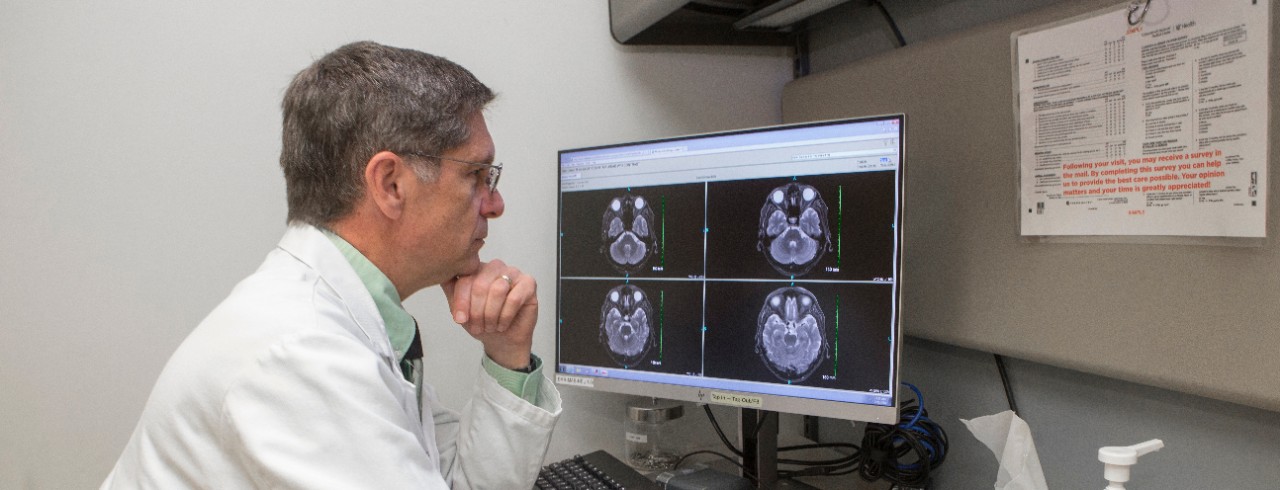
Thrombectomy less beneficial in large-core stroke
UC expert comments on trial results to Medscape
Thrombectomy, a minimally invasive stroke procedure that uses a catheter to remove a blood clot from a blood vessel in the brain to restore blood flow, has been shown to be beneficial in patients with large-core ischemic stroke.
But a secondary analysis of data from the randomized SELECT2 trial recently showed that patients with the greatest volume of tissue injury may benefit less from the procedure.
The analysis used imaging and outcome data from the 322 patients with large-core ischemic stroke included in the trial to look at whether the occurrence of severe hypodensity modified the effect of thrombectomy.
The results showed that as the volume of severe hypodensity increased, the odds of a favorable outcome with thrombectomy decreased.
The University of Cincinnati's Joseph Broderick, MD, commented on the study findings to Medscape.
"These data, if validated, provide a more fine-tuned approach to the use of endovascular therapy in patients with larger volumes of ischemic core," said Broderick, professor in the University of Cincinnati’s Department of Neurology and Rehabilitation Medicine in the College of Medicine and director of the UC Gardner Neuroscience Institute.
Broderick explained that greater intensity of hypodensity has been recognized as a marker for a greater likelihood of unsalvageable brain.
"There are some parallels with diffusion/flair mismatch that have been used to identify patients who may benefit from reperfusion," he said. "The next step will be to test these parameters in other published and reported large-core trials, but time to first image and time to treatment will be important variables to be considered in validating these data and incorporating them into clinical practice."
Featured photo at top of Dr. Broderick. Photo/Joseph Fuqua II/University of Cincinnati
Related Stories
President picks exceptional talent
April 28, 2021
The University of Cincinnati 2021 Presidential Leadership Medal of Excellence Awards honor six undergraduate scholars for scholarship, leadership, character, service and the ideals of the university. Awardees are spotlighted for exceptional academics, creativity, community service and innovation.
Grad students earn president's highest honor
April 28, 2021
The University of Cincinnati 2021 Presidential Medal of Graduate Student Excellence Awards honor three graduate scholars for scholarship, leadership, character, service and the ideals of the university. Awardees are spotlighted for exceptional academics, creativity, community service and innovation.
UC student leads effort to clean up campus adjacent Coy Field
April 7, 2021
Karthikeyan Sakthivel, a senior medical sciences undergraduate at the University of Cincinnati, has adopted Coy Field in an attempt to keep the green space clean and ready for use by UC students, area high schoolers and the community. Sakthivel is planning another cleanup event for Coy Field, which is adjacent to the university campus.
The making of a successful Faculty & Staff Campaign
May 25, 2021
More than one-third of UC’s nearly 7,000 faculty and staff have already contributed to the 2020-21 Faculty & Staff Campaign, putting the goal of 45% within reach.
GIVEHOPE and BSI Engineering Celebrate Ten Years of Driving Research
August 3, 2021
Years after two personal losses from pancreatic cancer, Cincinnati-based nonprofit GIVEHOPE and consulting firm BSI Engineering are celebrating a philanthropic partnership that has funded 13 pilot research projects at the University of Cincinnati Cancer Center.
Finding community and building a future
July 9, 2021
As a University of Cincinnati College of Medicine student, Sarah Appeadu, MD, ’21, remembers journaling on the “3 Cs” that got her through medical school: Community, community, community. Now, when she lists the people who supported her through four years of training—the last year in a global pandemic—it keeps growing: her family, her church, her classmates, and the college’s Office of Student Affairs and Office of Diversity, Equity and Inclusion. “I look back and it was such a crucial time to really be nurtured in that way,” she says. “I’m so thankful that I had those people. It shows being around the right people really mattered. That’s my same hope for residency even.”
UC to honor 2,079 grads at summer Commencement
August 2, 2021
UC celebrates the 2021 summer Commencement on Friday in two ceremonies at Fifth Third Arena. On Saturday, UC will recognize 2020 grads with an in-person Commencement celebration.
New York Times: Flint Weighs Scope of Harm to Children Caused by Lead in Water
February 1, 2016
Kim Dietrich, a professor of environmental health at UC's College of Medicine, is quoted in this story on the medical problems that could develop among the thousands of young children exposed to lead-contaminated water in Flint, Mich.
Cancer-Causing Gene Found in Plasma May Help Predict Outcomes for Patients
February 18, 2016
Researchers at the University of Cincinnati have discovered that a human cancer-causing gene, called DEK, can be detected in the plasma of head and neck cancer patients.
UC Receives $1.9 Million to Study Pain
February 15, 2016
Jun-Ming Zhang, MD, of the UC College of Medicine, is the principal investigator of a $1.95 million grant to study the interacting roles of the sympathetic and sensory nervous and immune systems in back and neuropathic pain models.
